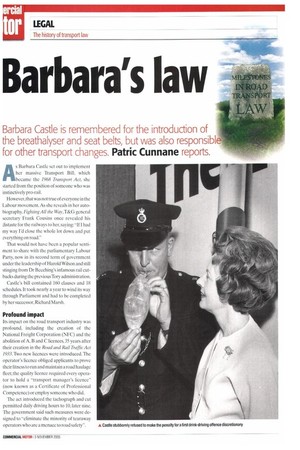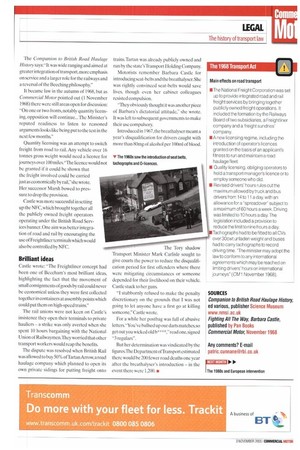Barbara's law
Page 36

Page 37

If you've noticed an error in this article please click here to report it so we can fix it.
Barbara Castle is remembered for the introduction of the breathalyser and seat belts, but was also responsibl for other transport changes. Patric Cunnane reports.
As Barbara Castle set out to implement her massive Transport Bill, which became the 1968 Transport Act, she started from the position of someone who was instinctively pro-rail.
However,that was not true of everyone in the Labour movement. As she reveals in her autobiography, Fighting All the Way, T&G general secretary Frank Cousins once revealed his distaste for the railways to her, saying: "If I had my way I'd close the whole lot down and put everything on road."
That would not have been a popular sentiment to share with the parliamentary Labour Party, now in its second term of government under the leadership of Harold Wilson and still stinging from Dr Beeching's infamous rail cutbacks during the previous Tory administration.
Castle's bill contained 160 clauses and 18 schedules. It took nearly a year to wind its way through Parliament and had to be completed by her successor, Richard Marsh.
Profound impact Its impact on the road transport industry was profound, including the creation of the National Freight Corporation (NFC) and the abolition of A. B and C licences, 35 years after their creation in the Road and Rail Traffic Act 1933. Two new licences were introduced. The operator's licence obliged applicants to prove their fitness to run and maintain a road haulage fleet; the quality licence required every operator to hold a "transport manager's licence" (now known as a Certificate of Professional Competence) or employ someone who did.
The act introduced the tachograph and cut permitted daily driving hours to 10, later nine. The government said such measures were designed to "eliminate the minority of tearaway operators who are a menace to road safety". The Companion to British Road Haulage History says:" It was wide ranging and aimed at greater integration of transport,more emphasis on service and a larger role for the railways and a reversal of the Beeching philosophy."
It became law in the autumn of 1968, but as Commercial Motor pointed out (1 November 1968) there were still areas open for discussion: On one or two fronts, notably quantity licensing, opposition will continue... The Minister's reputed readiness to listen to reasoned arguments looks like being put to the test in the next few months."
Quantity licensing was an attempt to switch freight from road to rail. Any vehicle over 16 tonnes gross weight would need a licence for journeys over 100 miles."The licence would not be granted if it could he shown that the freight involved could be carried just as economically by rail," she wrote. Her successor Marsh bowed to pressure to drop the provision.
Castle was more successful in setting up the NFC, which brought together all the publicly owned freight operators operating under the British Road Services banner. One aim was better integration of road and rail by encouraging the use of Freightliner terminals which would also be controlled by NFC.
Brilliant ideas
Castle wrote: -The Freightliner concept had been one of Beecham's most brilliant ideas, highlighting the fact that the movement of small consignments of goods by rail could never be economical unless they were first collected together in containers at assembly points which could put them on high-speed trains."
The rail unions were not keen on Castle's insistence they open their terminals to private hauliers a strike was only averted when she spent 10 hours bargaining with the National Union of Railwaymen.They worried that other transport workers would reap the benefits.
The dispute was resolved when British Rail was allowed to buy 50% of Tartan Arrow, a road haulage company which planned to open its own private sidings for putting freight onto trains. Tartan was already publicly owned and run by the state's Transport Holding Company.
Motorists remember Barbara Castle for introducing seat-belts and the breathalyser. She was rightly convinced seat-belts would save lives, though even her cabinet colleagues resisted compulsion.
"They obviously thought it was another piece of Barbara's dictatorial attitude," she wrote. It was left to subsequent governments to make their use compulsory Introduced in 1967, the breathalyser meant a year's disqualification for drivers caught with more than 80mg of alcohol per 100m1 of blood.
The Tory shadow Transport Minister Mark Carlisle sought to give courts the power to reduce the disqualification period for first offenders where there were mitigating circumstances or someone depended for their livelihood on their vehicle. Castle stuck to her guns.
"I stubbornly refused to make the penalty discretionary on the grounds that I was not going to let anyone have a first go at killing someone," Castle wrote.
For a while her postbag was full of abusive letters." You've ballsed up our darts matches,so get out you wicked old h****:' read one,signed "3 regulars".
But her determination was vindicated by the IiguresThe Department ofTransport estimated there would be 200 fewer road deaths one year after the breathalyser's introduction in the event there were 1,200. SOURCES Companion to British Road Haulage History, ed various, publisher Science Museum www.nmsi.ac.uk
Fighting All The Way, Barbara Castle, published by Pan Books Commercial Motor, November 1968
Any comments? E-mail patric.cunnane@rbi.co.uk










































































































































































































